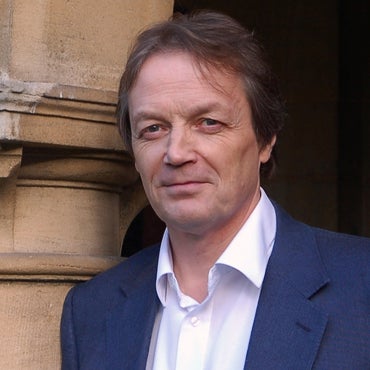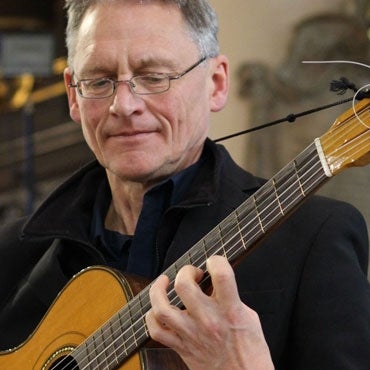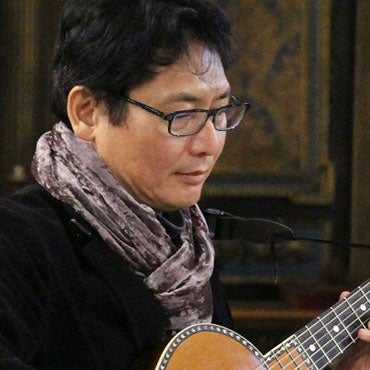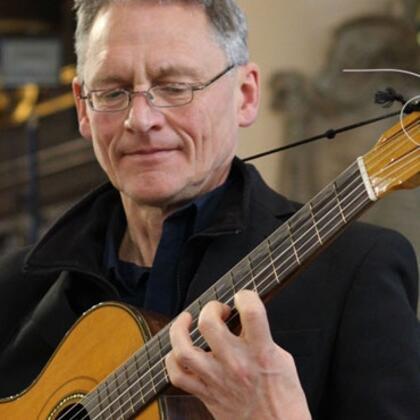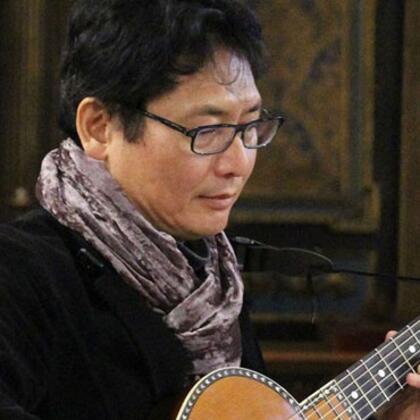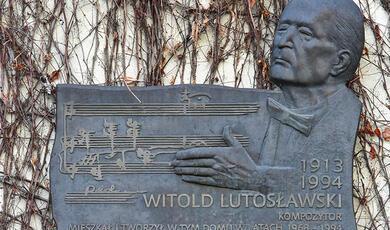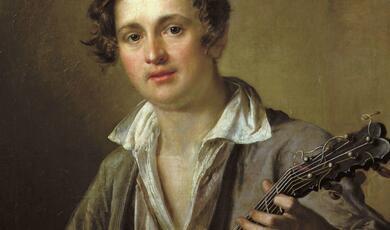The Guitar, the Steamship and the Picnic: England on the Move
Share
- Details
- Transcript
- Audio
- Downloads
- Extra Reading
In the early nineteenth century, there developed an intimate and unique association between the eminently portable guitar, an instrument capable of full harmony, and new forms of travel. Between 1800 and 1820 a new fashion for picnics arose, together with a vogue for sketching parties to capture picturesque scenes or ruins. The guitar was an ideal instrument for the many different movements of a society that was becoming increasingly mobile well before the beginnings of the railway. By 1825, steamships could be hired for excursions down the Thames or, moving out through the estuary, to Margate or to Dieppe; this kind of excursion, complete with guitars, is described by Charles Dickens in Sketches by Boz. As a result, certain coastal resorts became important centres of amateur guitar playing, and one, namely Brighton, where this lecture will come to rest, grew in royal favour to the point where major players gave recitals there.
Download Transcript
11 December 2014
The Guitar, the Steamship and the Picnic:
England on the Move
Professor Christopher Page
I would like to begin with a poem by William Blake, first published in his collection Songs of Innocence in 1789. Many of you will know it; it is entitled The Chimney Sweeper, and you have it, in Blake’s illustrated copy, on the first page of your handout:
When my mother died I was very young,
And my father sold me while yet my tongue
Could scarcely cry weep! weep! weep! weep!
So your chimneys I sweep & in soot I sleep.
There’s little Tom Dacre, who cried when his head
That curled like a lamb’s back, was shaved, so I said,
“Hush, Tom! never mind it, for when your head’s bare,
You know that the soot cannot spoil your white hair.”
And so he was quiet, and that very night,
As Tom was a-sleeping he had such a sight!
That thousands of sweepers, Dick, Joe, Ned, & Jack,
Were all of them locked up in coffins of black;
And by came an Angel who had a bright key,
And he opened the coffins & set them all free;
Then down a green plain, leaping, laughing they run,
And wash in a river and shine in the Sun.
Then naked and white, all their bags left behind,
They rise upon clouds, and sport in the wind.
And the Angel told Tom, if he’d be a good boy,
He'd have God for his father & never want joy.
And so Tom awoke; and we rose in the dark
And got with our bags and our brushes to work.
Though the morning was cold, Tom was happy and warm;
So if all do their duty, they need not fear harm.
Blake seems to be adopting the manner of verse intended for children, and ends with the kind of warning that such poetry often used to contain: ‘So if all do their duty, they need not fear harm’. Be good, in other words, and nothing hurtful will happen. Yet for all the simplicity of its narrative, and the seeming clarity of its moral resolution, the poem is decidedly unnerving, or at least I find it so. Is a poet famous for his radical views really advising children – or anyone else – to be quiet and obedient in the year of the French revolution? Does the poem in fact express a compassion that is all the more haunting, and a desire for reform that is all the more urgent, for being expressed with such seeming naivety, thinly concealing much that is troubling to both the mind and the heart?
No doubt that question might be answered in many ways. Today, I would like to suggest that part of the imaginative energy of this poem comes from Blake’s horror of being confined, like the chimneysweepers, within a tiny chamber of brick, and a longing for release that the children receive in their vision by being able to laugh and run in green fields, the scene that Blake chose to illustrate with the text. The background to the poem, in other words, is the massive expansion of London and other brick-built cities in the century between 1750 and 1850. Think of all those long brick corridors in Dickens: in Little Dorrit, for example, where we enter ‘An old brick house, so dingy as to be all but black…’, or go down what Dickens calls ‘one of the parasite streets; long, regular, narrow, dull and gloomy; like a brick and mortar funeral…’. Today I would like to explore how the guitar, during the first decades of the nineteenth century in England, became the favourite instrument for those seeking a means of escape, however brief, from the dense and expanding towns and cities of the Industrial Revolution. This was partly a desire to leave the overpopulated conditions of London as its new terraces ate into the meadows and fields of the suburbs, to say nothing of Birmingham and Manchester. I have begun with that, because I think it is fundamental. But there are also more positive sides to the movement such escape involved. Think of how social life had improved in the eighteenth century with the rise of assembly rooms, balls, card parties, subscription libraries and their associated reading rooms. Many towns acquired public theatres towards 1800, finally liberating touring companies of actors, and well-meaning amateurs, from performances in drafty barns or shabby rooms of the public inns. By 1800, in other words, many provincial cities had a public culture that made them places worth visiting.
So by escape, I mean more than the flight from ‘parasite streets; long, regular, narrow, dull and gloomy’; I also mean movement for the sake of leisure made possible by new means of travel, notably by the invention of the steam ship soon after 1800, the rise of the cruise and by a general increase of foreign travel. I also mean movement for the sake of sightseeing and tourism, inspired by new forms of guidebook and published prints that shaped landscapes, or scenes of medieval ruined abbeys or castles, into picturesque views and glimpses so congenial to a sentimental and romantic sensibility.
The history of words is very revealing here. Take the word excursion, for example, in the familiar sense of ‘A journey or ‘trip’ undertaken for the sake of pleasure or health’. It is not found in that sense before 1779. (Some of you may be thinking here of William Wordsworth’s poem The Excursion, first published in 1814). Or take the word pic-nic, from the French; this only acquired its modern sense (‘an informal meal eaten out of doors, esp. as part of an excursion to the countryside, coast, etc’) in the early nineteenth century. Before that time, a picnic was generally ‘a fashionable social event at which each guest contributed a share of the food’.
In an age before portable record players, let alone other more recent and sophisticated ways of carrying music with you, the fashion for excursions and picnics created an obvious need for a portable, serviceable instrument, accommodating to amateurs. So I would now like to introduce you to a man, almost entirely forgotten, who discerned this need very early and strove to invent a series of instruments that would meet it. His name was Edward Light. He died at an advanced age in 1832 and much of his life was spent trading here in London. He invented, and then either made or had made by others, a series of hybrid stringed instruments with hybridized names such as ‘harp-lute’ and ‘harp-guitar’. Here is a notice that he placed in The Morning Post and Gazetteer, for Saturday, May 2, 1801:
To some extent, the horizon of Light’s work was much broader than the mere picnic or excursion; he was trying to sell portable instruments for British merchants, investors and colonial administrators going to India or the West Indies, where the sugar and tobacco plantations were served by slaves and white immigrants (one of his advertisements wisely, but perhaps none too truthfully, emphasizes that his instruments can withstand all kinds of climate). So there is a sense in which Edward Light belongs with the various firms that existed, in London and elsewhere, to equip British civil servants, sailors, soldiers and others with desks, trunks, saddles and so on, before travelling to very different climes. But you will have noticed the reference in the advertisement I quoted to house, garden, voyage, travel and the watering places. Edward Light’s aim was to make instruments that were elegant, portable and would even fit in a portmanteau, to take on a trip.
When we look at contemporary pictures, it is not always clear which of Light’s various hybrids we are seeing; you have an image of one on the second page of your handout, a fashion plate dated (by hand) to 1830, which is only two years before Light passed away; I think this is what Light would have called his ‘Dital Harp’, the ‘ditals’ being the small tongues of metal which the player could turn to change the tuning of the strings. Notice, incidentally, the flat base; the instrument was clearly designed to stand on a surface when not in use; with its decorated pillar and lyre like form, it was intended to be viewed as a piece of neo-classical furniture, as well as musical instrument.
I am delighted to say that we have one of thee vary rare instruments here with us, and what is rarer still, someone who can play it. Taro is going to play a harp-lute marked ‘INVENTER LIGHT/BARRY MAKER’, and he will play a piece from Edward Light’s own publication, Introduction to the art of playing on the harp-lute & apollo-lyre with suitable lessons (London, c.1820) on a 12 string harp-lute. It is an arrangement of a piece by Haydn.
Music Example: Taro Takeuchi,for Introduction to the art of playing on the harp-lute & apollo-lyre with suitable lessons (London, c.1820)
When Light refers to the ‘watering places’, he partly has in mind some foreign resorts visited by the wealthy, but he also is also thinking of the British spas and seaside resorts. For it was during his lifetime that a fishing village in Sussex called Byrhthelmstone was rapidly transformed into a royal watering place called Brighton, and when the spa town of Cheltenham boomed as nobody in 1750 could have anticipated. Let me quote you a passage from Griffith’s New historical description of Cheltenham (London, 1826):
Cheltenham has now, with its twenty thousand inhabitants, assumed the aspect of a city. It is distinguished by a vigilant and well regulated police: it has its abundantly supplied markets, its arcades and bazaars, botanic gardens, and riding schools; its numerous and liberally supported charitable establishments; and its capacious and commodious hotels, at and from which near seventy coaches are daily arriving and departing.
Edward Light’s hybrids did not survive very long (hybrids rarely do) and I think it is very telling that we find him in 1817, now very late in his career, advertising yet another creation, ‘a new invented (Patent) portable instrument…not larger than a Spanish guitar, and in every respect the most desirable little instrument ever invented’. Notice the sense of competition there with the Spanish guitar. That had now become the excursion and picnic instrument par excellence: the instrument of England on the move.Contemporary prints were quick to register this. The second page of your handout shows an engraving entitled A View from Richmond Hill, published in 1823. As various elegant ladies and gentlemen take the air, others enjoy various Sunday pleasures; one lady is sketching, another is reading to a small group. Just to their right, waiting to be trodden on, there lies a guitar.
Music Example: Ulrich Wedermeir, Fernando Sor (1778-1839), Andante from op. 58.
There is more to this than the portability and cheapness of guitars, or the ease with which they could be loaded with a picnic hamper on the top of a coach. There was a longstanding association between the softly voiced guitar and the landscapes of Spain, or more broadly of the Mediterranean, imagined in northern Europe as regions where sounds moved languidly on the warm breezes in the moonlit summer nights, when all competing noises had died down, save perhaps the vesper bell. The imagery of guitars, in other words, was rich in languor and ease, offering what John Keats would call ‘a full beaker of the warm south’, not the rush of trying to rehearse, publicise and then perform a Beethoven symphony or a string quartet in London. This is the kind of writing, for example, you could expect to find in the serialised fiction of the early 1800s, when guitars are heard:
Here we are, embowered amid citrons, oranges and myrtles, almost fainting with their sweetness; with the moon gently trembling over the ocean and the ancient turrets of our chateau; environed by a choir of nightingales…
Or this, referring to hearing the guitar in Spain:
Sometimes I have heard the strings ringing in such whispers of strange concord, that you would have thought they but echoed to the touch of the silken wings of the wild bees as they flew across them.
An association between the guitar, water and moonlight was projected in any number of popular prints sold or given away with albums of various kinds. The third page of your handout gives an example. I am not sure how the romantic associations of the guitar could go much further than they do here; a Venetian gondola moves forwards in the moonlight, neoclassical architecture worthy of Claude Lorrain stands high on the hill, a mermaid or Lorelai combs her hair…
You may think this is very far from the business of actually composing music for the guitar but it was not. One of the most influential guitarists in nineteenth-century England, Madam Pratten, composed an impromptu for the guitar entitled ‘Twilight’. She was careful to preface the score with this little piece of purple prose:
And at the end of the score she placed this note:
On a lovely summer’s evening I sat watching the Sun go down, and the twilight gradually creeping over the scene. I took up my guitar and the gradual stillness as my fingers strayed over the strings, this little musical sketch ‘Twilight’ was produced. And as the gentle breeze rose and subsided, so did the sound of the strings swell and diminish.
It is quite obvious that Madam Pratten, whose career had begun as a child prodigy in the 1830s, is fictionalising herself here, writing herself, so to speak, into the imagery of contemporary prints and serialized stores in a most revealing way.
Musical Example: Ulrich Wedermeier, Madame Pratten: ‘Twilight’.
The new fashion for picnics after 1800 was another way in which the romantic associations of the guitar with the open air were realised. A common term for the picnic in the new sense (the one we know) was the ‘gypsy party’, as if the picnickers were to become nomads for the day, eating in the open, lying on the ground: a rural jaunt with a cart of provisions, carriages, horses to experience life for a moment ‘under the Greenwood Tree’. Here is a passage froma piece in the Gentleman’s Magazine for 1819, entitled ‘On the Picturesque Features of the South Downs’:
We formed what is called a gipsey party in Sussex and Hampshire; all excursions to chosen spots is in refined imitation of the vagabondizing and unceremonious freedom of those tawny wanderers, nor is it altogether a bad counterfeit of Arcadian happiness.
Or try this, from a new magazine revealingly entitled The Tourist, October 8, 1832:
There is a species of entertainments peculiar to our islands, called…at Greenwich and Richmond ‘pic-nics’…you give up the comforts of civilised life— tables and chairs are De Trop — one glass does the work of many — and your dinner is spread on the grass, for the benefit of the ants, earwigs, and other insects.
And finally form the Giulianiad, the first niche magazine for guitarists in English, in an issue for 1833:
In a gipsy party, also – where there must be a sprinkling of romance, and an oblivion of the dull cares of the world…what instrument can be listened to with so much reverence and buoyant pleasure?...In all such situations of festive mirth and convivial recreation, the guitar is the instrument of joy and gladness’.
The figure of the gypsy guitarist, of course, is as old as Cervantes.
Such picnics with their guitars were often satirized, a sure sign that they had become very common:
Needless to say, this trip ended badly, for the theme of the ruined picnic is one to which comic writers of the period often return:
The rise of the pic-nic coincided with the mature taste for visiting picturesque and romanticised Gothic ruins, evoking the vanished age of medieval chivalry, which is so important to romanticism. Here is a passage from Benjamin Disraeli’s novel, Vivian Grey (1826):
‘Has your Ladyship yet been to the Castle of Nassau?...You should go. The ruin is one of the finest in Germany. An expedition to Nassau Castle would be a capital foundation for a pic-nic. Conceive a beautiful valley, discovered by a knight, in the middle ages, following the track of a stag. How romantic! The very incident vouches for its sweet seclusion. Cannot you imagine the wooded mountains, the old grey ruin, the sound of the unseen river? What more should we want, except agreeable company, fine music, and the best provisions, to fancy ourselves in Paradise?’
The third page of your handout shows a page from an undated scrapbook, probably of the 1820s or ‘30s. The scene in the centre, with a Spanish guitar, is pastoral and Mediterranean with a palm tree offering shade from an implied sun. This is very much the terrain of guitar reverie in the serialised fiction of the day; but notice what the compiler of this book has placed all round the central image: there are views of country houses, the ‘ancient turrets’ of various castles, quiet spots in the countryside and picturesque medieval ruins, all neatly framed in cheap, picturesque views probably sold with penny publications. The page has clearly been planned, but in the associative and unself-conscious way that often gives old scrapbooks their unique position. They are informal maps of the imagination. (You have surely noticed that the man is wearing a kilt. The guitar scene at the centre may have some connection with an opera or play with a Scottish theme derived, however loosely, from Walter Scott, quarried by many composers of the period from the humblest anonymous up to Rossini)
I come finally to the steamship. Here at last was a form of travel by water that was independent of wind, tide, or current. By 1814, plans were hatched for a Thames steam Packet leaving from Queenhithe and touring to Richmond and Windsor. Your handout shows the kind of vessel. The year of Waterloo, 1815, brings the steam packet to Margate; 1821, and subscriptions for shares offered for a Brighton-Dieppe steam packet. Once again, the guitar proved ideal for what Edward Light had long before called voyage and travel; the romantic image of the guitar on the water, during a moonlit night, found a daily land chugging reality on board on board a pleasure boat.
And once again, the satirists moved in. One of the finest early stories by Charles Dickens is entitled The Steam Excursion, originally published in 1834. It tells of a pleasure trip organized by a ne’er-do-well law student, Percy Noakes, of Gray’s Inn. He arranges for a Thames cruise, with lunch to be laid out on deck and dinner in the cabin ‘to be provided by ‘an eminent City purveyor’. A band is booked, quadrilles are to be danced, ‘and then, whoever we know that’s musical, you know, why they’ll make themselves useful and agreeable…’. The Briggs sisters arrive with three guitars, which are stowed in the hold ‘accompanied by two immense portfolios of music, which it would take at least a week’s incessant playing to get through’.
There are about fifty persons on board, mostly minor figures from the London legal world. The Steam ship is The Endeavour, belonging to the Steam Navigation Company. They set off from London Bridge Wharf. Quite soon we have the unforgettable guitar episode, and the ensuing disaster as a squall breaks out ‘The throbbing motion of the engine was all too perceptible’.
Now,' said Mr. Percy Noakes, who had just ascended from the fore-cabin, where he had been busily engaged in decanting the wine, 'if the Misses Briggs will oblige us with something before dinner, I am sure we shall be very much delighted'…
The three Misses Briggs looked modestly at their mamma, and the mamma looked approvingly at her daughters…The Misses Briggs asked for their guitars, and several gentlemen seriously damaged the cases in their anxiety to present them. Then, there was a very interesting production of three little keys for the aforesaid cases, and a melodramatic expression of horror at finding a string broken; and a vast deal of screwing and tightening, and winding, and tuning, during which Mrs. Briggs expatiated to those near her on the immense difficulty of playing a guitar…At length, the Misses Briggs began in real earnest. It was a new Spanish composition, for three voices and three guitars. The effect was electrical…
Most of those on the voyage were no doubt trying to escape the kind of law office so feelingly described by Dickens in The Pickwick Papers: ‘on the ground-floor front of a dingy house, at the very farthest end of Freeman’s Court, Cornhill’ where the clerks could catch ‘as favourable glimpses of heavens light and heaven’s sun, in the course of their daily labours, as a man might hope to do, were he placed at the bottom of a reasonably deep well’. Let us hope that the evocation of Spain, in the guitar music they heard, gave them some dim sense that, all their bags left behind, they could rise upon clouds, and sport in the wind.
Music Example: Ulrich Wedermeier: Trinidad Huerta (1800 - 1874), Two Divertimentos for Angiolina Panormo
© Professor Christopher Page, 2014
This event was on Thu, 11 Dec 2014
Support Gresham
Gresham College has offered an outstanding education to the public free of charge for over 400 years. Today, Gresham plays an important role in fostering a love of learning and a greater understanding of ourselves and the world around us. Your donation will help to widen our reach and to broaden our audience, allowing more people to benefit from a high-quality education from some of the brightest minds.


 Login
Login
